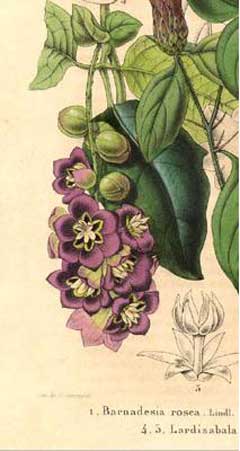 |
|
http://commons.wikimedia.org/wiki/File:Lardizabala.JPG |
 |
|
Translate this page:
Summary
Physical Characteristics

 Lardizabala biternata is an evergreen Climber growing to 3.5 m (11ft 6in).
Lardizabala biternata is an evergreen Climber growing to 3.5 m (11ft 6in).
See above for USDA hardiness. It is hardy to UK zone 9 and is frost tender. It is in leaf all year, in flower from December to February. The species is monoecious (individual flowers are either male or female, but both sexes can be found on the same plant). The plant is not self-fertile.
Suitable for: light (sandy) and medium (loamy) soils and prefers well-drained soil. Suitable pH: mildly acid, neutral and basic (mildly alkaline) soils. It can grow in semi-shade (light woodland). It prefers moist soil.
UK Hardiness Map
US Hardiness Map
Synonyms
Plant Habitats
Woodland Garden Dappled Shade; Shady Edge; East Wall. By. South Wall. By. West Wall. By.
Edible Uses
Edible Parts: Fruit
Edible Uses:
Fruit - raw or cooked. Sweet and pulpy[2, 3, 11], it is considered to be a delicacy in Chile where it is collected and sold in local markets[183]. Also of interest value because of its sausage-like deep purple fruits[183]. The fruit is 5 - 8cm long[188].
References More on Edible Uses
Medicinal Uses
Plants For A Future can not take any responsibility for any adverse effects from the use of plants. Always seek advice from a professional before using a plant medicinally.
None known
References More on Medicinal Uses
The Bookshop: Edible Plant Books
Our Latest books on Perennial Plants For Food Forests and Permaculture Gardens in paperback or digital formats.

Edible Tropical Plants
Food Forest Plants for Hotter Conditions: 250+ Plants For Tropical Food Forests & Permaculture Gardens.
More

Edible Temperate Plants
Plants for Your Food Forest: 500 Plants for Temperate Food Forests & Permaculture Gardens.
More

More Books
PFAF have eight books available in paperback and digital formats. Browse the shop for more information.
Shop Now
Other Uses
Fibre
A cordage is made from the stems[1, 61].
Special Uses
References More on Other Uses
Cultivation details
Prefers a well-drained humus-rich sandy loam in a shady protected position[200]. It requires a sunny wall according to another report[182], whilst others say that it succeeds in sun or semi-shade[188, 219]. A very ornamental plant[1], but it is only hardy in the mildest areas of Britain tolerating occasional lows to -10°c[184]. The young growth in spring can be damaged by late frosts. The fruits are only formed in this country after a long hot summer[166, 219]. Plants climb by means of twining[182], they do not really need pruning[219]. The flowers can be monoecious or dioecious. Male and female flowers are carried on the same plants[188]. The edible fruit is sold in the local markets in Chile and Peru[46].
References Carbon Farming Information and Carbon Sequestration Information
Temperature Converter
Type a value in the Celsius field to convert the value to Fahrenheit:
Fahrenheit:
The PFAF Bookshop
Plants For A Future have a number of books available in paperback and digital form. Book titles include Edible Plants, Edible Perennials, Edible Trees,Edible Shrubs, Woodland Gardening, and Temperate Food Forest Plants. Our new book is Food Forest Plants For Hotter Conditions (Tropical and Sub-Tropical).
Shop Now
Plant Propagation
Seed - sow spring in a greenhouse[200]. Prick out the seedlings into individual pots when they are large enough to handle and grow them on in the greenhouse for at least their first winter. Plant out in early summer and, if possible, give the plants some protection for their first winter outdoors. Cuttings of half-ripe wood, 5 - 10cm long with a heel, June/July in a frame[78]. The cuttings should be put in individual pots[78]. A good percentage[78]. Stem cuttings in spring and autumn[200].
Other Names
If available other names are mentioned here
Native Plant Search
Search over 900 plants ideal for food forests and permaculture gardens. Filter to search native plants to your area. The plants selected are the plants in our book 'Plants For Your Food Forest: 500 Plants for Temperate Food Forests and Permaculture Gardens, as well as plants chosen for our forthcoming related books for Tropical/Hot Wet Climates and Mediterranean/Hot Dry Climates. Native Plant Search
Found In
Countries where the plant has been found are listed here if the information is available
Weed Potential
Right plant wrong place. We are currently updating this section.
Please note that a plant may be invasive in one area but may not in your area so it’s worth checking.
Conservation Status
IUCN Red List of Threatened Plants Status :

Growth: S = slow M = medium F = fast. Soil: L = light (sandy) M = medium H = heavy (clay). pH: A = acid N = neutral B = basic (alkaline). Shade: F = full shade S = semi-shade N = no shade. Moisture: D = dry M = Moist We = wet Wa = water.

Expert comment
Author
Ruiz.&Pav.
Botanical References
11200
Links / References
For a list of references used on this page please go here
Readers comment